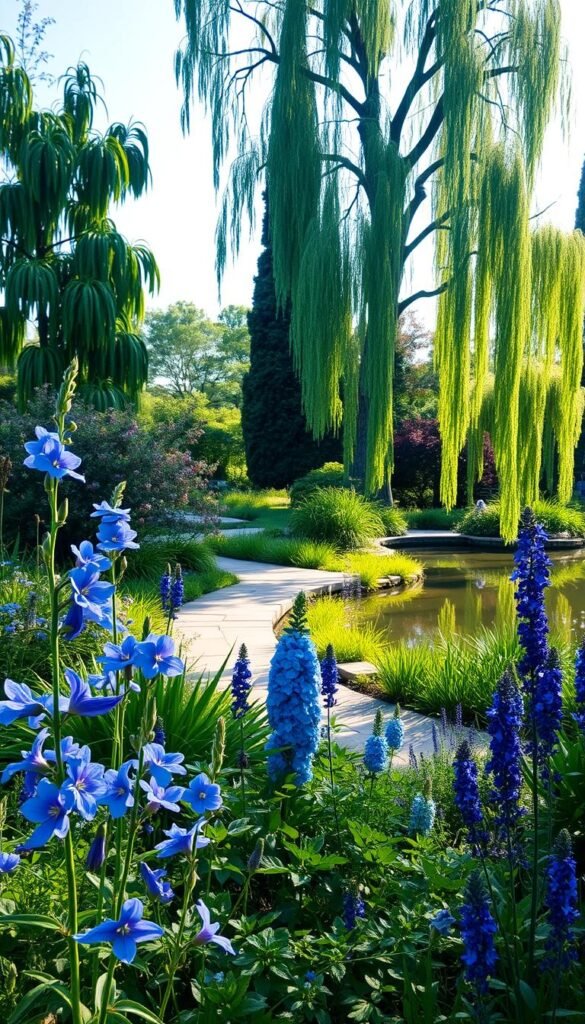Imagine stepping into a space where time slows and stress fades. Certain botanical wonders achieve this effortlessly, offering shades so rare they feel almost magical. Less than 10% of plants produce these elusive tones naturally, relying on clever adaptations like pH shifts or light-reflecting cells instead of true pigments.
Why do these cool-toned blossoms captivate us? Their scarcity plays a role, but so does their impact on our minds. Studies show cooler shades in natural settings lower heart rates and encourage mindfulness. Picture delicate petals in soft cerulean or deep indigo creating pockets of calm in your yard—perfect for unwinding after a long day.
Designing with these hues isn’t just about beauty—it’s a strategy. When paired with silvery foliage or pale accents, they make small spaces feel larger. Their versatility shines in both modern and cottage-style layouts, proving rare doesn’t mean fussy.
Ready to explore how these living gems can transform your landscape? We’ll guide you through standout varieties, growth tips, and creative pairings that turn ordinary areas into sanctuaries of elegance. Whether you’re crafting a meditation corner or refreshing your front yard, discover why gardeners prize these specimens as nature’s ultimate design tool.
Discover the Calming Magic of Blue Flowers
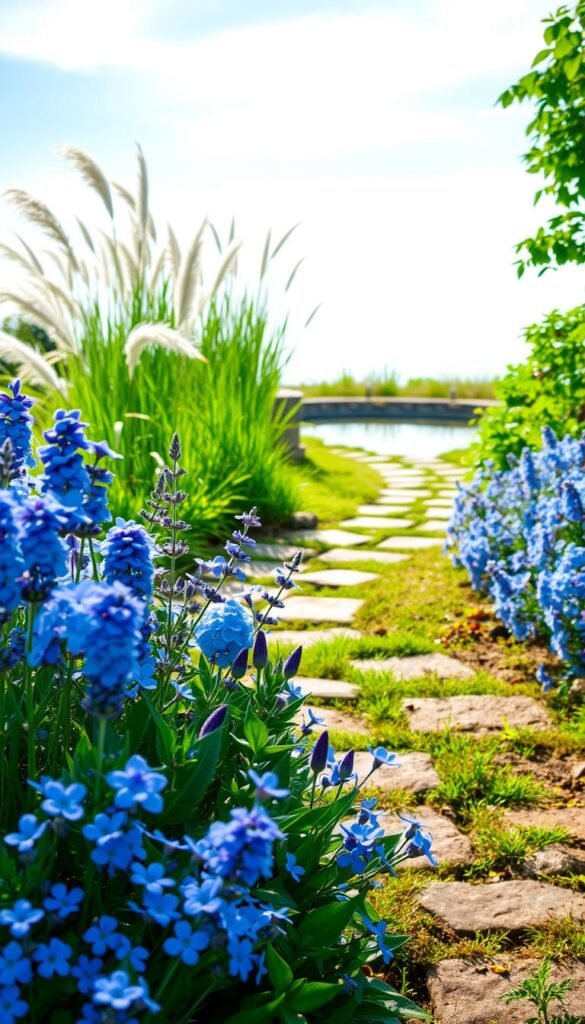
Have you ever wondered why certain shades in nature feel instantly soothing? Unlike common reds or yellows, cooler tones create visual retreats that help minds unwind. This effect comes alive in spaces featuring rare azure blossoms—a chromatic marvel found in less than 10% of plants worldwide.
Research reveals that viewing cooler hues lowers cortisol levels by up to 15%, making these specimens ideal for creating relaxing nooks. Their scarcity adds allure—no animals or minerals naturally produce true sapphire pigments. When you incorporate them, they become living art pieces that spark curiosity.
| Variety | Light Needs | Bloom Season | Visual Impact |
|---|---|---|---|
| Hydrangea | Partial shade | Summer-Fall | Large clusters |
| Gentian | Full sun | Late summer | Vibrant spikes |
| Lobelia | Shade-friendly | Spring-Fall | Cascading form |
Strategically placing these receding-color plants along fence lines tricks the eye into perceiving depth. Even compact yards gain a spacious feel. Pair them with gray-green foliage to amplify their cooling effect during sweltering afternoons.
What truly sets them apart? Their adaptability. Whether your plot basks in sunlight or hides under tree canopies, varieties exist to thrive. They maintain their striking appearance from dawn’s soft light to midday brilliance, offering consistent beauty.
Embracing the Rarity of True Blue Blooms
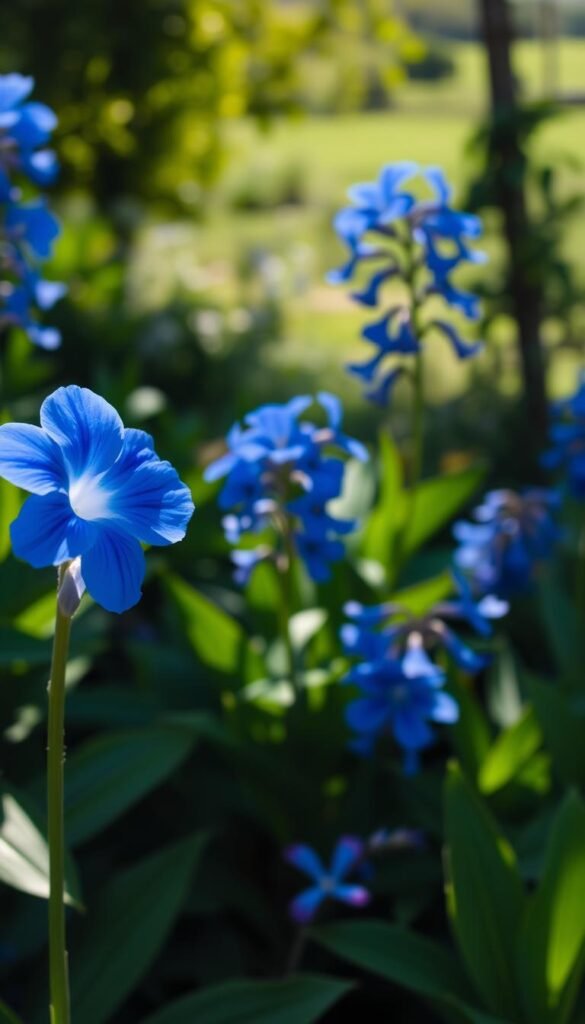
What if your garden held treasures rarer than sapphires? Less than 10% of flowering species produce authentic azure petals naturally. Unlike common reds or yellows, these specimens achieve their striking hue through clever tricks—like adjusting soil acidity or bending light through microscopic cell structures.
Spotting genuine examples requires a keen eye. Many varieties marketed as “blue” lean toward purple or violet undertones. True types display clear sky tones without reddish hints—a trait that makes them prized among collectors. Their scarcity transforms them into living heirlooms, elevating ordinary spaces into showstopping displays.
Why does this matter for your landscape? These plants:
- Create instant focal points that spark conversations
- Pair beautifully with silver-leaf companions for moonlit elegance
- Symbolize peace in Japanese traditions and wisdom in European folklore
While challenging to source, their value lies in uniqueness. Each bloom becomes a testament to nature’s ingenuity—reminding us that rarity often carries the deepest magic. As you plan your beds, remember: true azure isn’t just a color. It’s a botanical marvel waiting to redefine your outdoor sanctuary.
The Science Behind Blue: Natural Pigments and Perceptions
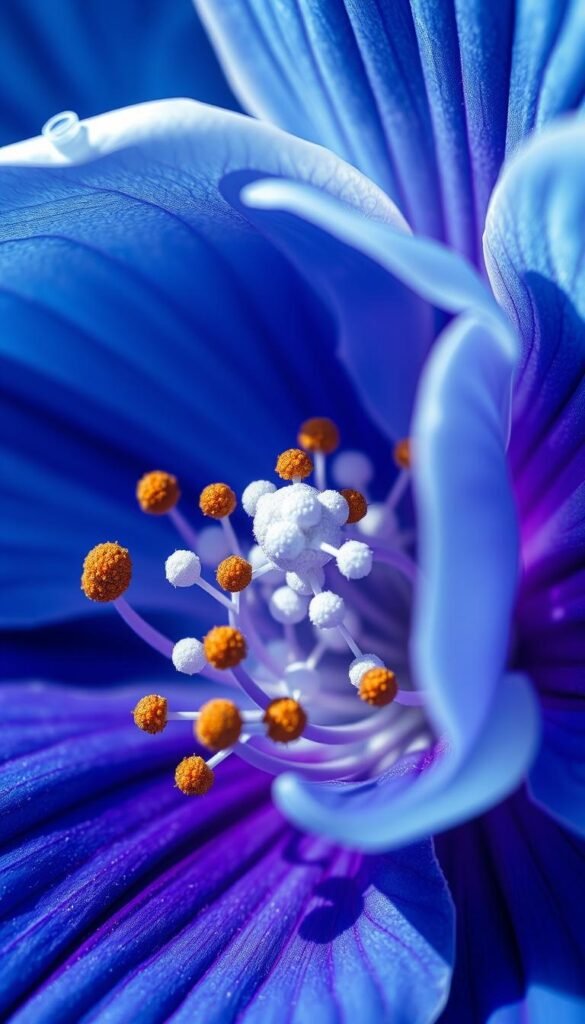
Behind every azure bloom lies a microscopic light show. Unlike common reds or yellows, true blue in nature isn’t a pigment—it’s a clever trick of chemistry and physics. Less than 10% of flowering species achieve this feat, making each blossom a marvel of evolution.
Understanding How Plants Create Blue Hues
These plants use anthocyanin pigments combined with aluminum ions and precise pH levels. Slight acidity shifts in cell sap turn pinkish pigments into sapphire tones. Some species add microscopic ridges to petals, bending light waves to enhance the blue effect.
Your garden’s soil acidity directly impacts color intensity. Hydrangeas famously shift from pink to blue in acidic soil. Breeders spend years perfecting hybrids that maintain stable hues across environments—a genetic puzzle requiring exact cellular conditions.
Why True Blue Remains a Gardener’s Treasure
Creating lasting azure tones demands specific genes and environmental harmony. Hybridizers often work decades to stabilize these traits. As one botanist notes: “Growing true blue isn’t gardening—it’s alchemy.”
This rarity makes them prized additions. When you explore blue garden designs, you’re curating living science experiments. Their fleeting beauty reminds us how extraordinary nature’s color palette truly is.
Blue Flower Garden Inspiration: Cool-Hued Blooms for Calming Vibes
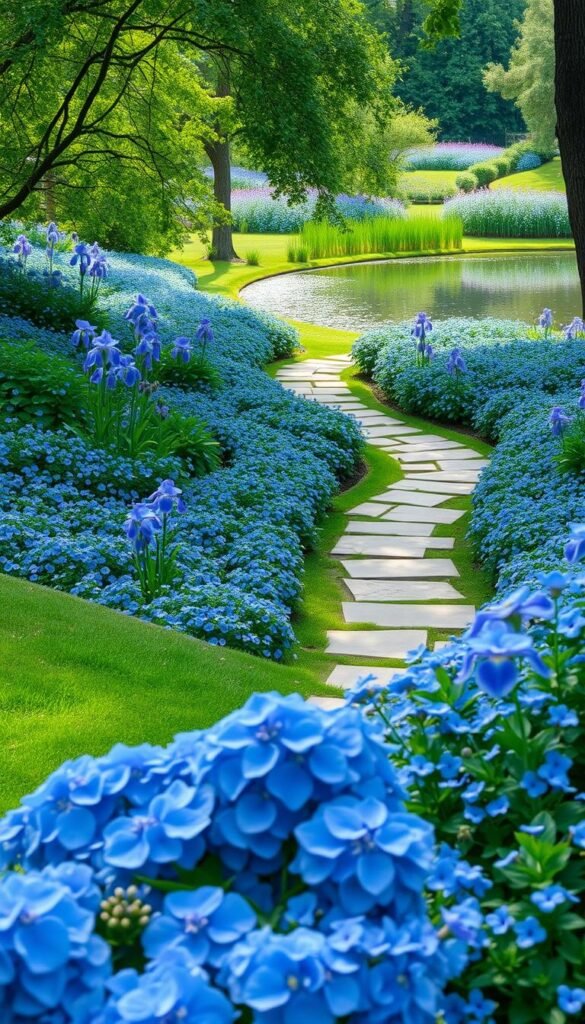
Transform your outdoor space using nature’s most tranquil palette. Azure blossoms offer endless design possibilities, whether you’re crafting a serene retreat or energizing a dull corner. Their cool tones work like visual poetry, softening harsh sunlight and creating natural focal points.
Monochromatic arrangements make bold statements. Try grouping varying heights—tall delphiniums behind midsize hydrangeas, with creeping lobelia at ground level. This layering technique adds dimension while keeping the color story cohesive. For contrast, pair them with warm-toned companions like golden marigolds or bronze sedges.
Different settings call for unique approaches. A meditation nook might feature soft cornflowers beside a stone bench, while a modern layout could showcase spiky eryngium against geometric planters. Even cottage-style beds gain charm when sapphire columbines spill over white picket fences.
Balance is key. Introduce textures through ornamental grasses or weathered wood elements to prevent monotony. As one landscape artist advises: “Let your azure stars shine by giving them simple, structured backdrops.” This approach keeps spaces feeling intentional yet relaxed.
With smart placement, these botanical gems elevate ordinary yards into curated escapes. They maintain visual interest from spring’s first buds to autumn’s final flourish, proving that thoughtful design outlasts seasonal trends.
Seasonal Blue Blooms: From Early Spring to Late Summer
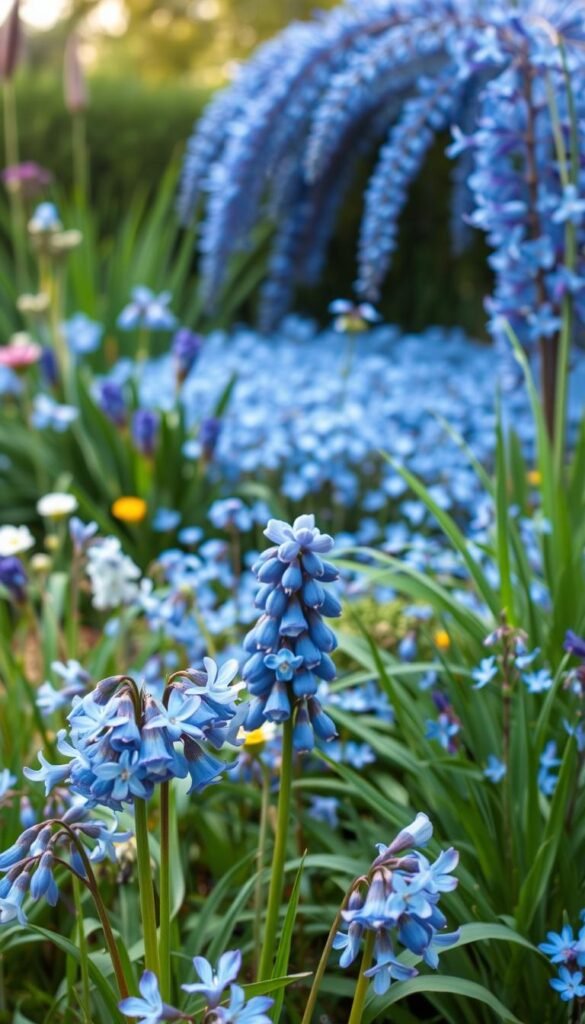
Curious how to keep your space awash in tranquil hues year-round? Timing is everything. By selecting varieties that bloom at different intervals, you craft a living timeline of soothing shades.
Invigorate Your Garden with Early Season Picks
Kickstart your display with Virginia Bluebells. Their buds blush pink before unfurling into sky-colored trumpets. These spring stars thrive in dappled shade and moist soil. Pair them with Grape Hyacinths—their cobalt spikes multiply yearly, forming dense carpets under trees.
| Plant | Bloom Period | Key Feature |
|---|---|---|
| Virginia Bluebells | Mid-spring | Color-changing buds |
| Grape Hyacinth | Early spring | Self-seeding bulbs |
| Siberian Squill | Late winter-spring | Deer-resistant |
Extending the Bloom Into the Warm Months
When temperatures rise, Blue Globe Thistle takes center stage. Its steely spheres shine from June through September, thriving in full sun. For vertical drama, try Summer Cloud Delphinium. These spires produce flowers repeatedly if deadheaded.
Heat-loving varieties need smart care:
- Mulch roots to retain moisture
- Water deeply at soil level
- Provide afternoon shade in hot zones
By staggering plantings and understanding each variety’s needs, you’ll enjoy serene hues from thaw to frost. One gardener notes: “It’s like conducting an orchestra—every section has its moment to shine.”
Attracting Pollinators with Blue Flowers
Ever notice how buzzing wings seem drawn to certain plants? Specific azure blossoms act like living welcome signs for butterflies, bees, and hummingbirds. By choosing the right varieties, your space becomes a vital pitstop for these essential creatures.
Blue Columbines work double duty—their upward-facing blooms invite hummingbirds while deterring deer. For continuous action, try Blue Butterfly Bush. Its honey-scented clusters pull in swallowtails from June through frost. Pair it with spiky Lupine, whose tower-shaped flowers attract bumblebees seeking sturdy landing pads.
Not all visitors prefer the same treats. Consider these pairings:
| Plant | Pollinator | Key Feature |
|---|---|---|
| Caryopteris | Honeybees | Drought-tolerant |
| Beyond Midnight Bluebeard | Monarchs | Late-season blooms |
| Catmint | Mason bees | Fragrant foliage |
Position fragrant varieties near seating areas where you can enjoy both scents and aerial acrobatics. Cluster flowers in groups of three to five—this “target planting” helps pollinators spot food sources quickly. As master gardener Elena Carter notes: “A well-planned azure border feeds eyes and ecosystems simultaneously.”
New to growing? Start with beginner-friendly flowers like Salvia or Russian Sage. These low-maintenance options offer abundant nectar while fitting seamlessly into existing designs. Remember—every blossom you add strengthens local biodiversity, turning your yard into a living conservation project.
Designing Your Garden with a Cool Blue Palette
Ever thought your outdoor space could become a living canvas? Mastering azure-toned arrangements starts with playing depth against delicacy. Imagine soft cornflower clusters dancing beside bold indigo spikes—this contrast creates movement while preserving tranquility.
Balance light and dark tones to guide the eye. Pale varieties like forget-me-nots brighten shadowy corners, while rich navy salvias pop in sunlit zones. Pair them with silvery artemisia or lamb’s ear to amplify cooling effects.
| Plant Type | Texture | Ideal Placement | Visual Effect |
|---|---|---|---|
| Delphiniums | Spiky verticals | Back borders | Height drama |
| Hydrangeas | Rounded clusters | Focal points | Soft fullness |
| Forget-Me-Nots | Airy sprays | Path edges | Gentle framing |
Mix foliage shapes to prevent flatness. Feathery Russian sage complements globe-shaped alliums, creating tactile interest. As landscape designer Mara Lin notes: “Texture turns monochrome into multisensory experiences.”
For evening charm, enhance your design with water features and fairy. Moonlit blossoms gain magical dimension when reflected in ponds or highlighted by subtle illumination. Remember—your palette should whisper serenity, not shout intensity.
Elegant Blue Shrubs and Perennials to Enhance Your Space
What gives your landscape staying power through seasons? Structural shrubs and reliable perennials form living architecture that supports fleeting beauty. These botanical anchors create depth while delivering seasonal surprises.
Blue Butterfly Bush: Summer’s Fragrant Showstopper
This shrub transforms spaces with honey-scented clusters from July through October. Its arching branches sway gracefully, inviting swallowtails to linger. Unlike fussy specimens, it thrives with basic care—just give it sunlight and occasional pruning.
Virginia Bluebells: Spring’s Color-Changing Wonder
Watch pink buds unfold into sky-hued bells each April. These woodland perennials multiply yearly, forming drifts under trees. Their oval leaves remain tidy, making them ideal for naturalized areas.
| Variety | Bloom Period | Key Features |
|---|---|---|
| Blue Butterfly Bush | Summer-Fall | Drought-tolerant, butterfly magnet |
| Virginia Bluebells | Spring | Self-seeding, deer-resistant |
Plant both for layered interest. Set taller shrubs behind bluebell colonies—their contrasting forms play well together. Improve soil with compost during installation, and mulch to retain moisture.
Expert tip: “Pair Virginia Bluebells with yellow primroses for a springtime contrast that pops,” suggests landscape designer Clara Mendez. This combo highlights their rare azure tones while brightening shady corners.
With proper care, these plants become more impressive yearly. The butterfly bush’s woody framework stays visible in winter, while bluebell patches expand into living carpets. Together, they prove that smart foundations make unforgettable gardens.
Artistic Inspirations: Blue Blooms in Garden Landscapes and Paintings
What if your outdoor space became a masterpiece? Vincent van Gogh proved it’s possible when he painted Irises in 1889, showcasing azure petals with bold brushstrokes. Like him, you can craft living art using nature’s rarest hues.
Artists cherish these specimens for their visual drama. Their uncommon tones create natural contrast against greenery, much like cobalt pigments pop on canvas. Position them where sunlight dances across petals—morning rays highlight delicate veins, while dusk softens edges into watercolor blends.
| Garden Element | Artistic Technique | Visual Effect |
|---|---|---|
| Color harmony | Analogous tones | Serene unity |
| Plant heights | Layered composition | Dynamic depth |
| Foliage textures | Brushstroke mimicry | Tactile interest |
Capture seasonal shifts like an impressionist. Spring’s soft cornflowers might whisper tranquility, while summer hydrangeas shout vibrancy. Photograph these changes to study nature’s palette—you’ll notice new details each time.
Landscape designer Marco Rossi advises: “Treat each planting bed as a framed canvas. Balance bold azure statements with neutral spaces to let the eye rest.” This approach turns ordinary yards into galleries where every angle offers fresh beauty.
Whether sketching or planting, remember: your garden isn’t just growing flowers—it’s cultivating inspiration. Like van Gogh’s irises, your arrangements will leave lasting impressions long after the last petal falls.
Essential Care Tips for a Thriving Blue Garden
Caring for azure blossoms combines science with simple joy. Start by matching each plant to its ideal spot—Blue Columbines flourish in well-drained soil with morning light, while their daisy cousins demand full sun exposure. Test your earth’s pH; many rare-hued varieties need slightly acidic conditions to maintain vibrant tones.
Water wisely. Deep weekly soakings beat daily sprinkles, encouraging stronger roots. Add mulch around specimens in partial shade to retain moisture without waterlogging. For container gardening, choose pots with drainage holes and refresh soil annually.
Group flowers by light needs. Sun-lovers like Blue Pimpernel thrive south-facing, while woodland types prefer dappled afternoon shade. Rotate potted specimens seasonally to ensure even sun distribution.
With these basics, your collection becomes a low-maintenance sanctuary. Remember: healthy blue flowers start with understanding their unique language of light, earth, and care.

